-

部编版语文八年级下册《庆祝奥林匹克运动复兴25周年》说课稿
一.说教材 1.教材所处的地位《庆祝奥林匹克运动复兴25周年》是人教版部编初中语文教材八年级下册第四单元“思想光芒”中的一篇经典演讲词。它是同学们接触过《 最后一次讲演》《应有格物致知精神》《我一生中的重要抉择》,初步了解、掌握关于演讲的一些技巧之后,再次让学生倾听那些穿越时空的声音,感受演讲精品的魅力,并总结、借鉴典范演讲的经验,在历练中提高演说才能。因为在现代社会中,良好的口语交际能力是公民的重要素养之一,它不但显示着一个人的语言水平,更体现着一个人的自信、智慧、教养与风度。2.教材分析 《庆祝奥林匹克运动复兴25周年》是顾拜旦于1919年4月在瑞士洛桑庆祝奥林匹克运动恢复25周年纪念会上的演说,是关于奥林匹克运动的重要文献。顾拜旦用诗歌般的语言阐述了奥林匹克精神的内涵与价值;以饱含喜悦的神情引领听众去联想奥林匹克精神无限美好的前景。这篇演说词和他的诗歌《体育颂》一起成为世界文化史和体育史上不朽的篇章。

人教版新目标初中英语八年级上册How do you get to school教案2篇
Step Ⅶ Role play ( Work on 1b)1. First ask two students to read the dialogue to the class.Sa: How do you get to school?Sb: Well, I ride my bike to the subway station. Then I take the subway.2. Now work with a partner.Suppose you use two kinds of transportation to get to school \Hangzhou\Beijing... (bus, train, subway, walking, bike, etc.) Tell how you get there. You may use the phrases in 1a.3. Then ask different pairs of students to present their conversations to the class.Step ⅧListening1. Work on 2a(1) First ask students to read the list of information that Thomas wants to know.…where Nina lives.…how far from school she lives.…how long it takes to get to school.…how she gets to school.…what she thinks of the transportation.(2) Tell students what transportation and bus stop mean.bus stop 汽车站 transportation n. 运送;运输Then tell students we'll hear a recording. Please put a checkmark in front of each thing that Thomas wants to know.(3) Now play the recording for students.( Have students pay attention to the sample answer.) (4) Then correct the answers.

人教版新目标初中英语八年级上册How do you make a banana milk shake教案2篇
1. First, ... then, ... next, ... finally, ...首先,……然后,……接着,……最后,……这是英语中表达做某事的步骤的一种说法。如果步骤较多,还可以说:first-next-after that-later on-finally/at last通常你会听到说英语国家的人在说 first, next, then, finally 和后面的内容时,他们会做一些停顿。这样就能提前告诉听者接下来讲的是一系列的步骤。这一点在朗读和听力中应特别注意。2. how many, how much均为疑问词,同是“多少”,但用法不同。请看:how many修饰可数名词复数,how much修饰不可数名词。但在用法上,同学们常犯如下错误:1) [误] How many are there bananas on the table?[正] How many bananas are there on the table?[析] how many, how much 中的many,much是形容词,常修饰名词作定语,故后面跟名词。2) [误]How much tea are there on the table?[正]How much tea is there on the table?[析] how much修饰不可数名词时,谓语动词用单数。how many与how much的区别可简记为:前how many:问“多少”,复数名词后面跑;how much问“多少”,不可数名词单数好。前者答语用基数词,后者答语用数量关系。

人教版新目标初中英语八年级上册How was your school trip教案2篇
“Go for it!” is based on “Task-Based Language Teaching”. It adheres to “The authenticity principle”, “The form-function principle”, “The task dependency principle” and “The principle of learning by doing”. These principles all accord with the demands of curriculum focus.In and of Grade Seven (II), “Go for it!”, students have learned “The Simple Past Tense”. And it appears again in of Grade Eight (I). teaches students more about how to talk about events in the past. In addition, it gives affirmative and negative statements in the past tense, such as the sentence patterns “Did you see …?” “Were there …?” “Did you go …?” As the first part of Unit 8, Section A opens with a picture presenting the last school trip in the aquarium and continues with several step-by-step practice activities, which are all good for students to master “The Simple Past Tense”. Doing well in Section A will help students integrate the new target language with that in Section B. Thus, they can describe the events in the past freely and foster their own ability of reflecting and practicing. II. Teaching ObjectivesTeaching objective is the beginning and aim of teaching activities. According to the overall goal of the English elementary course--- improve students' synthetic ability of language application, which should be based on the development of students’ “Language knowledge”, “Language skills”, “Character building”, “Learning strategies” and “Cross-cultural awareness”. The teaching objectives are described as follows(I). Knowledge objectivesi. Master the simple past tense of regular and irregular verbsii. Recite the new words and expressions about the last school trip in the aquarium, including their pronunciation and intonation

人教版新目标初中英语八年级上册I’m more outgoing than my sister教案2篇
1 交通工具的比较此活动为小组活动。学生通过讨论找出到达某一城市可乘坐的各种交通工具,并选择最佳出行方式。Teacher:We’re going to Shanghai. How many ways can we use to get there? Yes, there are four ways: by bus, by plane, by train, by ship. Please discuss how you are going to get there.操作建议:(1)学生以小组为单位展开活动,谈论本组所选择的交通工具。(2)各组选代表向全班汇报,阐述本组所选择的交通工具的利和弊。完成任务所需要的语言结构:We can go there by ship. It’s more comfortable and cheaper than any other transportation.We can go there by bus. It’s cheaper but it takes longer time.2 哪个城市更合适?此活动具有挑战性。假设中国要举行2014年世界杯足球赛,分别从历史,人文,天气等方面对各城市(北京,大连,上海,昆明)进行比较,选择最佳举办城市。T: Imagine China is holding the 2014 FIFA World Cup. Which city do you think is the best for the World Cup, Beijing, Dalian, Shanghai or Kunming? Let’s work in groups. If you choose Beijing, please join the Team Red. If you chose Dalian, please join the Team White. If you choose Shanghai, please join the Team Blue. If you choose Kunming, please join the Team Green. Please show us its advantages. Then let’s see which team will win.

人教版新目标初中英语八年级上册What’s the best radio station教案2篇
教学重点和难点:运用所掌握的语言描述,比较不同地点的特点。在练习中学习掌握英语比较级和最高级的用法。课前准备分配小组,每组五至六人。通过上网或翻阅报刊杂志等方法,确定旅游线路,做出基本的旅游计划。教学设计:本节课流程图 学法指导:1.由于这是一堂新课,在教学中应注意面向全体,发挥学生的主体性,引导学生积极参与,激发学生的求知欲和学习积极性,指导学生积极思维,主动获取知识,养成良好的学习方法。逐步学会独立解决问题。总之要尽可能调动学生的非智力因素促进智力因素的发展。教法选择:1.电化教学法2.课堂讨论法3.任务型教学法采用这些方法的目的是为了充分调动学生的学习积极性,使学生变被动学习为主动学习。通过电脑形象的演示,加强印象,提高兴趣,突破难点,提高教学效率,进而增大教学的容量和信息量。充分体现教师为主导,学生为主体的教学原则。

人教版新目标初中英语九年级上册Teenagers should be allowed to choose their own clothes教案2篇
Step 1 Greeting Greet the class and check the homeworkStep 2 A duty report The S on duty gives a report on the rules in his home and lead in 3a “Sun Fei’s and Wu Yu’s rules” Step 3 ReadingSs read the conversation and write the two girls’ rules in the chart. Check the answers.Get Ss to read after the tape and then read aloud by themselves. Then, T explains the language points.Step 4 Pairwork 3bRole play. Use the information in chart to practice with the conversation in 3a covered. They can look at the sample conversation in the right box.Step 5 Task 2 “Who’s the best reporter?”Make a survey by asking any 5 students the questions in the chart in activity 4. Then give out a report about it. See who is the best reporter? And the best reporter will get a nice ball-pen.Step 6 Summary and homework:Write out the report in your exercise-books.Period ThreeStep 1 Greeting and a duty reportThe S gives a duty report talking about his experience of being late for school. Lead in the question “Do you ever get to school late? How often do you get to school late? Always, usually, sometimes, or never?Step 2 1a Get Ss to finish writing.Step 3 Pairwork 1b Get Ss to talk about their answers with their partners using the sample conversation in the box on the right.Step 4 Listening practice2a Lead-in: What will happen if you get to school late? What about Peter? Let’s listen to a conversation between Peter and his father. Get Ss to finish 2a (As usual, for the first time, Ss only listen.) Check the answers.

人教版新目标初中英语九年级上册How do you study for a test教案2篇
内容提示本单元主要内容是学会利用verb十by/with gerund表示方式方法来讨论学习英语的策略,认识自己在学习方面的长处和不足。初步了解现在完成时的结构和用法。现在完成时由助动词have/has+动词的过去分词构成,主要表示过去发生的某一动作对现在仍有影响或造成的后果,常与already,yet,just,ever,never等副词连用。教学目标一、学习目标(Language Goal) 1. Talk about how to study . 学会讨论各种学习方法和策略。2. Find out your suitable learning methods. 找出适合自己的学习方法。 二、语言结构(Language Structures) 1. Verb + by with gerund by+动名词短语 表示“通过…途径,方法” 2. How questions have引导的特殊疑问句 三、目标语言(Target Language) 1. How do you study for tests ? 你是怎样准备考试的?Well , I study by working with my classmates. 哦,我和同学们一起学习。2. Have you ever studied with a group ? 你曾经参加过学习小组吗?Yes , I have . I’ve learned a lot that way . 是的,参加过。通过这种方式我学了许多。

人教版新目标初中英语九年级上册Where would you like to visit教案2篇
The First PeriodⅠ.Teaching Aims and DemandsKnowledge Objects(1) Key Vocabularytiring, educational, fascinating, thrilling, peaceful, exotic, trek, jungle, take it easy, explore, historic, site(2) Target LanguageWhere would you like to go on vacation?I’d like to trek through the jungle, because I like exciting vacations.2. Ability Objects(1)Train students to talk about places they would like to visit with the target language.(2)Train students to describe vacations with different adjectives.(3)Train students' listening skill.3. Moral Object,It′s more interesting to go on vacating somewhere instead of staying at home.Ⅱ. Teaching Key Points1. Key Vocabularytiring, educational, fascinating, thrilling, peaceful, exotic, trek, jungle, take it easy, explore, historic, site2. Target LanguageTalk about different places with the target language.Ⅲ. Teaching Difficult Points1. Describe vacations with different adjectives.2. Talk about different places with the target language.Ⅳ. Teaching Methods1. Teaching by illumination2. Teaching by doing chain drills3. Teaching by pairworkⅤ. Teaching Aids1. A tape recorder2. Some pictures of different places with famous views

人教版新目标初中英语八年级上册What are you doing for vacation教案2篇
Teaching goals : 1. Words & phrases: babysit ,get back , fishing , rent , think about , decide(on) , tourist etc. 2. How to talk about future plans . 3. 现在进行时表示将来计划或行动. 4. 特殊疑问句(where , when , how long引导) Important and difficult points : Drills :What are you doing for vacation ? I’m watching TV . When are you going ? I’m going … . How long are you staying ? We’re staying for five days . Teaching aids : cards and a tape ,a large wall calendar . Period 1 Teaching procedures : Step 1Leading in1. Free talk . 2. Put up the wall calendar . T: I’m staying home on Saturday (pointing to next Saturday ).Ss repeat . Ss: I’m staying home on Saturday . T: OK. Today we’ll learn how to talk about future plans. Step 2Pre-task SB Page 13 , 1a . 1. Look at the picture carefully and tell what you see in the picture . 2. Write the activities from the pictures in the box and add some more . 3. Practice reading . Step 3While-task1. Using the activities we write in 1a to make conversations .For example :What are you doing for vacation ? I’m visiting my uncle . 2. Pairwork .Practice in pairs . 3. 用第三人称练习对话.

人教版新目标初中英语八年级上册What’s the matter教案2篇
She shouldn’t go to the party tonight.Step7. TaskT: You know, there are lots of problems in our life. If you are a doctor, please tell us how to solve the problem. I will divide you into 9 groups. Please work in groups. And then choose one of you to report your ideas.The following are the problems:I have a toothache.I am hungry. I have a sore throat.I am stressed out. I have a sore back.I am tired. I can’t sleep.I have a cold. I have a headache.Report: If you have a headache, you should go to bed early. You should see the doctor. You should eat some medicine. You shouldn’t wash your face with cold water.You shouldn’t sleep late.You shouldn’t swim.…..T encourages the students to give advice as much as possible.Homework:1. Chose one of the problems, and write down your advice2. Copy the new words这一步是用于热身的,同时也可以让他们复习一部分的表示人体部位的单词,扩充知识.学习语言的过程也是一个不断积累的过程,复习旧知识,增添新知识.通过小游戏,强化学生对Does she/he have…这个句子的运用能力.通过复习,自然的引到下面新知识的学习。充分利用表格,由句子到对话,再到文章,让学生循序渐进. 提高学生的综合语言运用能力,运用以前学过的知识来解决身边的问题.Period 5 (Section B 3a—3c, selfcheck)教学内容与分析:
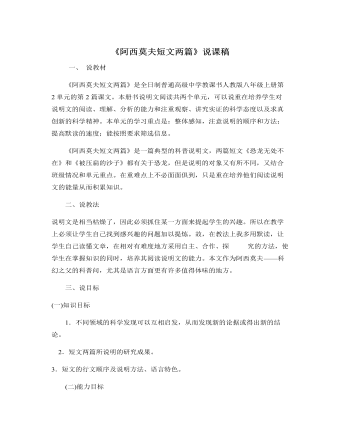
部编版语文八年级下册《阿西莫夫短文两篇》说课稿
一、 说教材《阿西莫夫短文两篇》是全日制普通高级中学教课书人教版八年级上册第2单元的第2篇课文。本册书说明文阅读共两个单元,可以说重在培养学生对说明文的阅读、理解、分析的能力和注重观察、讲究实证的科学态度以及求真创新的科学精神。本单元的学习重点是:整体感知,注意说明的顺序和方法;提高默读的速度;能按照要求筛选信息。《阿西莫夫短文两篇》是一篇典型的科普说明文,两篇短文《恐龙无处不在》和《被压扁的沙子》都有关于恐龙,但是说明的对象又有所不同,又结合班级情况和单元重点。在重难点上不必面面俱到,只是重在培养他们阅读说明文的能量从而积累知识。二、说教法说明文是相当枯燥了,因此必须抓住某一方面来提起学生的兴趣。所以在教学上必须让学生自己找到感兴趣的问题加以提炼。故,在教法上我多用默读,让学生自己读懂文章,在相对有难度地方采用自主、合作、探 究的方法,使学生在掌握知识的同时,培养其阅读说明文的能力。
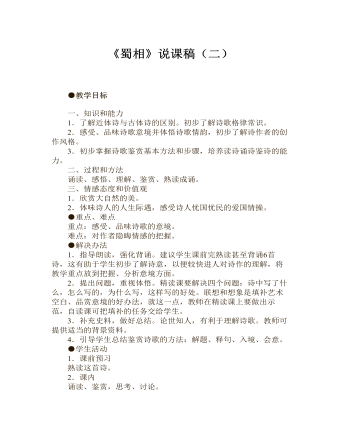
《蜀相》说课稿(二) 2021-2022学年统编版高中语文选择性必修下册
2.体味诗人的人生际遇,感受诗人忧国忧民的爱国情操。●重点、难点重点:感受、品味诗歌的意境。难点:对作者隐晦情感的把握。●解决办法1.指导朗读,强化背诵。建议学生课前完熟读甚至背诵6首诗,这有助于学生初步了解诗意,以便较快进人对诗作的理解,将教学重点放到把握、分析意境方面。2.提出问题,重视体悟。精读课要解决四个问题:诗中写了什么,怎么写的,为什么写,这样写的好处。联想和想象是填补艺术空白、品赏意境的好办法,就这一点,教师在精读课上要做出示范,自读课可把填补的任务交给学生。3.补充史料,做好总结。论世知人,有利于理解诗歌。教师可提供适当的背景资料。4.引导学生总结鉴赏诗歌的方法:解题、释句、入境、会意。
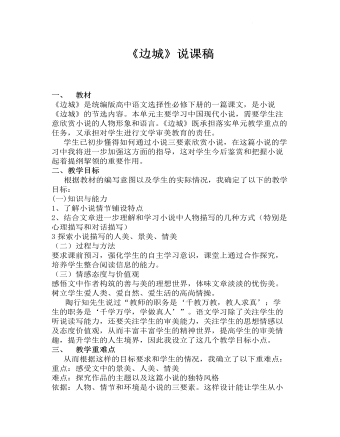
《边城》说课稿2021-2022学年统编版高中语文选择性必修下册
(重点突破一)1、分析环境描写 探讨边城的景美?(重点突破二)2、分析人物形象 探讨边城的人性美和人情美?至此,以三要素为切入口,文章的重点已分析完毕,下一个步骤就是突破难点。第二课时首先回顾上节课所讲的内容 (5分钟)(四)(难点突破)探究主题我设计了这样两个问题:1、小说表达了什么样的主题?(5分钟)2、有人说:《边城》从头到尾都隐藏着一种淡淡的愁绪,说说你的认识?从这篇小说中你可以看出沈从文先生的哪些显著的写作特点?(15分钟)这是两个定向设问的探究题,目的性很明确,就是为了突破难点,探究文章主旨。为了帮助学生理解文章的主旨,我用多媒体向学生 介绍《边城》的写作背景,给出“边城”的解题。对于第一个题,学生的答案可能会有很多种,比如“美”“爱”“纯”“和谐”“自然”等等,只要能基本概括,理由充足即可。
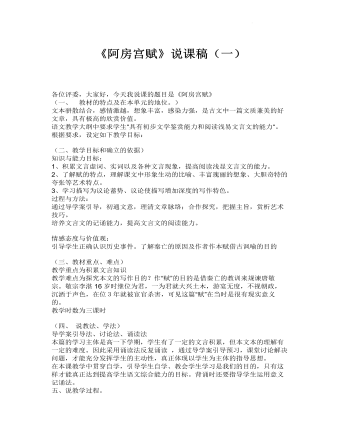
《阿房宫赋》说课稿(一) 2021-2022学年统编版高中语文必修下册
各位评委,大家好,今天我说课的题目是《阿房宫赋》 (一、 教材的特点及在本单元的地位。)文本骈散结合,感情激越,想象丰富,感染力强,是古文中一篇文质兼美的好文章,具有极高的欣赏价值。语文教学大纲中要求学生“具有初步文学鉴赏能力和阅读浅易文言文的能力“。根据要求,设定如下教学目标:(二、教学目标和确立的依据) 知识与能力目标:1、积累文言虚词、实词以及各种文言现象,提高阅读浅显文言文的能力。2、了解赋的特点,理解课文中形象生动的比喻、丰富瑰丽的想象、大胆奇特的夸张等艺术特点。3、学习描写为议论蓄势、议论使描写增加深度的写作特色。过程与方法:通过导学案引导,初通文意,理清文章脉络;合作探究,把握主旨,赏析艺术技巧。培养文言文的记诵能力,提高文言文的阅读能力。情感态度与价值观:引导学生正确认识历史事件。了解秦亡的原因及作者作本赋借古讽喻的目的
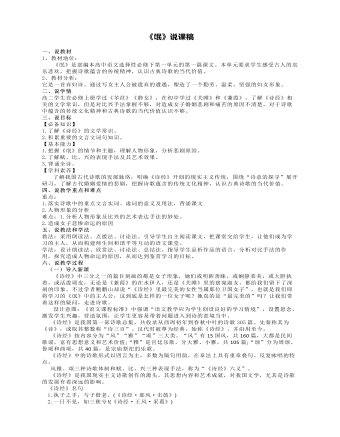
《氓》说课稿-2020-2021学年统编版高中语文选择性必修下册
“将子无怒”急于成婚,至于发怒,表现出急躁的性格特征;“二三其德”,又表现出他品德的败坏;“言既遂矣,至于暴矣”婚后的暴躁,婚前的热烈,婚后的离弃,两相对照,则揭示了他的虚伪自私。总之,氓是个性情狂暴、违背诺言、始爱终弃、不负责任、自私的负心汉。设计意图:用流行语概念引导学生去解读不同作品中的人物,培养学生比较分析的能力。3、探究《氓》中造成女子婚姻悲剧和痛苦的原因有哪些?个人原因:①氓的三心二意,不负责任。文中说“女也不爽,士贰其行”,女子怨恨的正是自己甘心贫困,辛苦操劳,多年如一日,但是最终还是被丈夫遗弃。②女子在经济上政治上处于附属地位。她生活天地狭小,生活的幸福与否全寄托在丈夫身上。如果遇上个对感情对家庭不负责任的丈夫,那她的悲剧是不可避免的。③性格悲剧。在男权社会中,女子在婚前行为草率,她与氓的恋爱缺乏牢固的思想基础,对氓的人品认识不足,认人不清导致的悲剧。社会的原因:
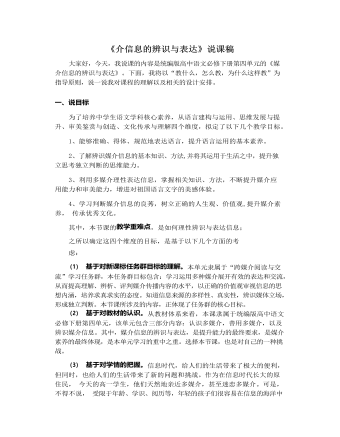
《媒介信息的辨识与表达》说课稿-2021-2022学年统编版高中语文必修下册
②癌症患者在治疗过程中,会有很大的身体损耗,而黄鳝有很好的滋补作用,适当吃一点黄鳝,既能够为患者补充营养,也能够提高患者的身体免疫力。 (来源于报纸)经过讨论交流,每一组一名同学自主发言,老师点拨,最后形成小结。看来源 要权威发布,不要道听途说看内容 要事实清晰,不要模糊遗漏看立场 要客观公允,不要情绪煽动看逻辑 要严谨准确,不要简单断言情感判断 理性判断 理性表达(四)活动三,重实践新课标提到,语文课程应引导学生在真实的语言运用情境中,通过自主的语言实践活动,积累经验,把握规律,培养能力。据此,我设计了以下贴近学生生活、可参与性强的活动。多媒体展示案例,仍然是先讨论交流,再自主发言,说出案例有哪些问题。这是某校园论坛上的一则寻物启示。
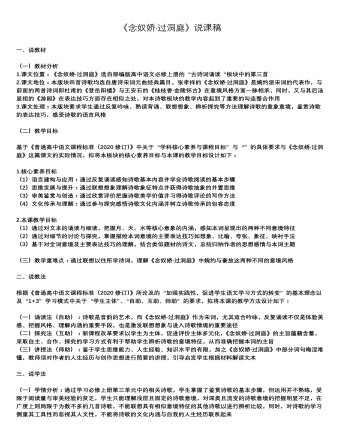
《念奴娇·过洞庭》说课稿 2020—2021学年统编版高中语文必修下册
明确:1.“孤光”象征受谗并被贬到边地的作者,表达了孤独落寞、忧谗畏讥、去国怀乡之情。2.“冰雪”运用比喻形容作者的心胸,表现了作者高洁的内在品格。3.“孤光”与“冰雪”相互映衬,月之明衬托了冰之洁,反之亦然,类似“素月”与“明河”的相互关系。4.“自照”中“自”表现了作者淡然自适与傲岸不羁的处世心态,“孤光自照”属于托物言志。问题7:分析下片第二、三句的表达效果明确:1.“短发萧骚”的细节描写表明作者年岁已高,壮志难酬,暗含凄凉惆怅之情。2.“襟袖冷”与“沧浪”暗示环境转向惊涛拍岸,风起云涌,渲染、象征险恶的仕途与坎坷的人生。3.“稳泛”反衬了作者安然自若的淡定心态、放浪形骸的伟岸风骨与超越现实的自由主义的进取精神。
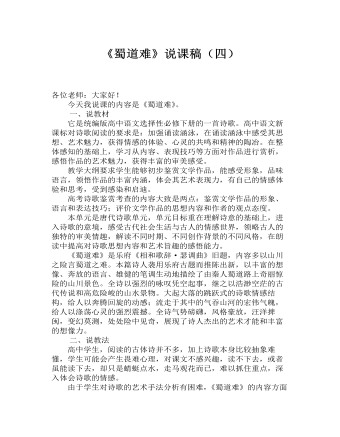
《蜀道难》说课稿(四) 2021-2022学年统编版高中语文选择性必修下册
再读(还是那两位学生)六、比较阅读(或者出一些诗句判断用的艺术手法)(依据理论联系实际教学原则)学的最终目的是用.我设计让学生判断诗句用的艺术手法的题型,使学生学以致用,而且还检验学生理解的程度,还测试教学效果。当发现学生对某个艺术手法掌握不好时,则及时地强化。李白与唐代的关系。指导阅读引申讨论(点出阅读的篇目《唐之韵》《走近李白》(不要)诗言志,诗往往抒发的是诗人的内心情感和自我追求,诗人的生平经历,丰富的生活经验和对生活的感悟都在诗歌中有反映。有句俗话“文如其人”。要了解诗作中的“我”为什么会这样哀怨,为什么会产生这样低调的情感。就必须了解诗人,才能更好地了解诗作,更深层次地理解诗歌形象背后的意蕴,把握好诗歌的基调。(为什么这样引导)
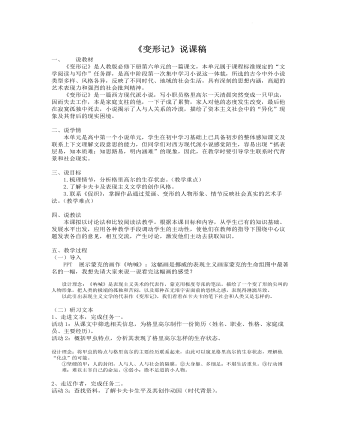
《变形记(节选)》说课稿 2021-2022学年统编版高中语文必修下册
五、教学过程(一)导入PPT 展示蒙克的画作《呐喊》:这幅画是挪威的表现主义画家蒙克的生命组图中最著名的一幅,我想先请大家来说一说看完这幅画的感受?设计理念:《呐喊》是表现主义美术的代表作,蒙克用极度夸张的笔法,描绘了一个变了形的尖叫的人物形象,把人类的极端的孤独和苦闷,以及那种在无垠宇宙面前的恐惧之感,表现得淋漓尽致。以此引出表现主义文学的代表作《变形记》,我们看看在卡夫卡的笔下社会和人类又是怎样的。(二)研习文本1、走进文本,完成任务一。活动1:从课文中筛选相关信息,为格里高尔制作一份简历(姓名、职业、性格、家庭成员、主要经历)。活动2:概括甲虫特点,分析其表现了格里高尔怎样的生存状态。设计理念:将甲虫的特点与格里高尔的主要经历联系起来,由此可以窥见格里高尔的生存状态,理解他“化虫”的可能。①坚硬的甲:人的封闭,人与人、人与社会的隔膜。②大身躯、多细足:不堪生活重负。③行动困难:难以主宰自己的命运。④弱小:微不足道的小人物。

